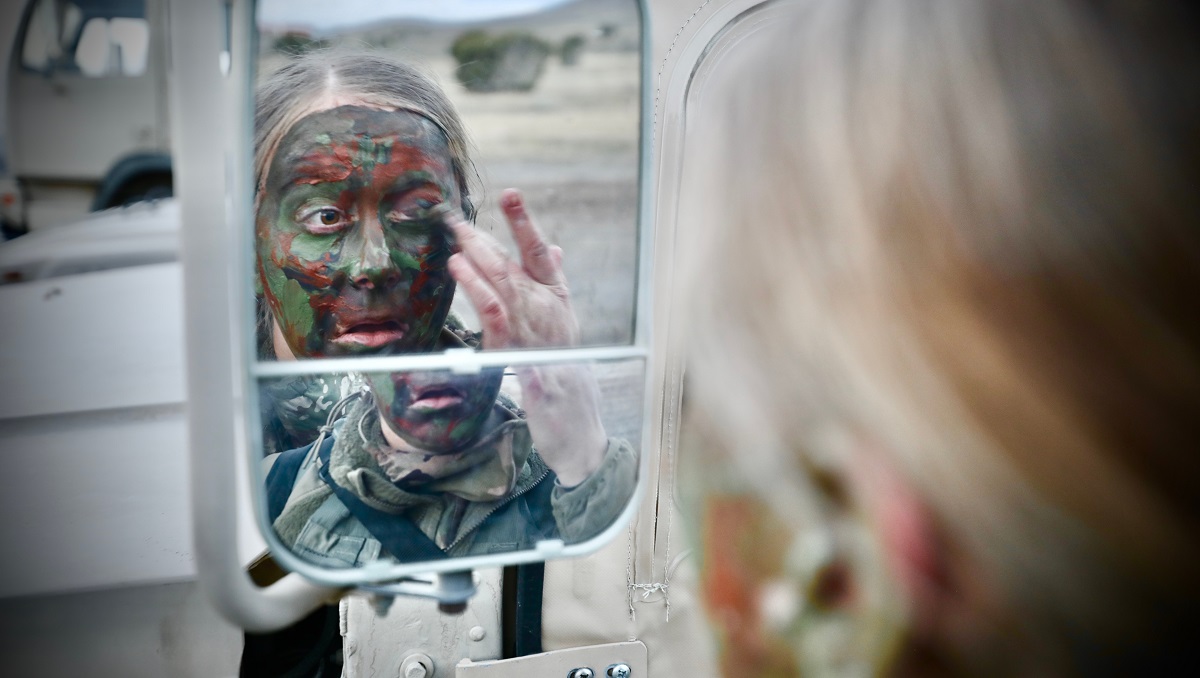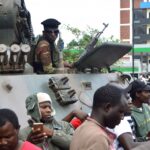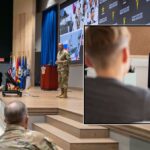
The U.S. Army War College continues to support the Army Chief of Staff’s (CSA) focus on warfighting. In this episode, podcast editor Ron Granieri sits with Isaac Henderson, Pamela Lovasz, and Rick Luce—three recent graduates of the resident course Carlisle Scholars Program—to discuss their research examining the challenges and possibilities of implementing a warfighting mindset across the force. Whether it’s adapting a concept like shoot, move, and communicate to non-combat career fields, folding Department of the Army civilians into the culture, or the overarching concept of trust in mission command, these three professionals share the insights of their study over the last year.
We were asking the same thing: ‘What does it mean to be a warfighter?’ Because a warfighter can look like your combat arms…but support of the warfighter can come from people like civilians, like myself. And for me personally, what that means is that we understand collectively, no matter what your job is…that you know that your role is, bare bones in my opinion, to support the warfighter…And so that was one of our sources of topics at the very beginning, and we moved out with this project with that understanding.
Podcast: Download
Isaac (Ike) Henderson is a lieutenant colonel and an Infantry Officer in the U.S. Army and a native of Chiefland, Florida. He entered the Army upon graduating from Boise State University in 2001. He holds an MA in Military Studies from American Military University and is currently enrolled at Liberty University to pursue a Ph.D. in Military History. LTC Henderson has held leadership positions from Platoon Leader to Battalion Commander and his assignments include one operational deployment in Puerto Rico, and six combat deployments in Iraq and Afghanistan. He is a graduate of the AY24 Resident Class of the U.S. Army War College and a member of the Carlisle Scholars Program.
Pamela Lovasz is an Army Civilian and Professional Engineer and Geologist assigned to the Army Corps of Engineers. She has served in leadership positions as an Army Civilian managing and supervising up to 200 employees as a Division Chief. Following the War College she is heading to New York City where she will serve the Army Corps of Engineers – New York District. She is a graduate of the AY24 Resident Class of the U.S. Army War College and a member of the Carlisle Scholars Program.
Rick Luce is a lieutenant colonel and Maneuver, Fires and Effects and Infantry Officer in the U.S. Army. He has served both as an enlisted soldier and officer as well as in the Army National Guard and on active duty. His assignments include multiple combat tours in Iraq and Afghanistan as well as a unique battalion command leading a Republic of Korea/U.S. Light Infantry Battalion in the Joint Security Area, or the DMZ between North and South Korea. He is a graduate of the AY24 Resident Class of the U.S. Army War College and a member of the Carlisle Scholars Program.
Ron Granieri is Professor of History at the U.S. Army War College and the Editor of A BETTER PEACE.
The views expressed in this presentation are those of the speakers and do not necessarily reflect those of the U.S. Army War College, U.S. Army, or Department of Defense.
Photo Description: Army Reserve Sgt. Jennifer Phillips, a medical logistics specialist, assigned to the 361st Medical Logistics Company, 807th MCDS, use a mirror on a humvee to carefully apply camouflage to her face before tackling a night land navigation course on Camp Williams, April 15, 2021. Phillips is one of fifteen Army Reserve Soldiers from around the country who recently came to Camp Williams to compete in a Joint Command Best Warrior Competition that challenged the Soldiers with five-days of rigorous physical and mental events ranging from the Army Combat Fitness Test to marksmanship, medical knowledge and warrior skills.
Photo Credit: Photo by Sgt. 1st Class Brent Powell





With regard to the “culture of warfighting,” might it be helpful to consider that this may be:
a. More related to a/the culture and thinking related to conventional/traditional warfighting — where nation-states engage each other with regular armies — and where the control of territory is often most important? And:
b. Less related to a/the culture and thinking related to irregular warfighting — where nation-states and/or non-state actors are the primary combatants — but where, in these instances, these contests are won or lost by controlling and influencing populations rather than defeating the opponent’s regular armies and occupying the opponent’s territory?
(Thus, for the infantryman, the cook, the clerk, etc., to think, learn and/or re-learn about “warfighting” — and its culture — this, more from the perspective of my item “a” above?)
A potential reason why our “culture of warfighting” today must be based only along conventional and/or nuclear warfighting lines, this being because the U.S./the West no longer seems to have the means to either defend the homeland — and/or to defeat our opponents either here at home and/or there abroad — this, via our other, normal, warfighting means, for example, via our normal irregular warfighting means.
To help explain this unfortunate phenomenon, let me suggest that the normal irregular warfighting means, suggested by the distinguished authors below, these such normal irregular warfighting means no longer seem to be available to the U.S./the West; this, due to the significant numbers of U.S./Western personnel no longer seeming to agree with, and/or subscribe to, same. In this regard, note that many U.S./Western personnel no longer seem to believe in such things as “religious pluralism,” “democracy,” “human rights,” “diversity, and “helping unfortunate population groups who seek alternatives to a life of fear, oppression, and injustice,” etc. — all of which is addressed below — and all which, at other times, would have been readily available to American warfighters.
“In the same way that the conventionally focused American way of war is defined by America’s technical and industrial capacity and technological edge, the American way of irregular war is tied to our notions of religious pluralism, democracy, and, above all, human rights. And although the American way of war protects us against near-peer powers and guarantees the lanes of global commerce, the American way of irregular war protects our way of life by both promoting our worldview and giving people the tools to realize the same opportunities that we have had. … ” (See beginning at the last paragraph of Page 5 of the Introduction chapter to Rand paper by LTG [ret.] Charles Cleveland entitled: “The American Way of Irregular War: An Analytical Memoir.”)
“The Achilles’ heel of our authoritarian adversaries is their inherent fear of their own people; the United States must be ready to capitalize on this fear. … An American way of irregular war will reflect who we are as a people, our diversity, our moral code, and our undying belief in freedom.” (See the “Conclusion” of the Rand paper “The American Way of Irregular War: An Analytical Memoir” by Charles T. Cleveland and Daniel Egel.)
“Advocates of UW first recognize that, among a population of self-determination seekers, human interest in liberty trumps loyalty to a self-serving dictatorship, that those who aspire to freedom can succeed in deposing corrupt or authoritarian rulers, and that unfortunate population groups can and often do seek alternatives to a life of fear, oppression, and injustice. Second, advocates believe that there is a valid role for the U.S. Government in encouraging and empowering these freedom seekers when doing so helps to secure U.S. national security interests.” (See the National Defense University Press paper “Unconventional Warfare in the Gray Zone” by Joseph L. Votel, Charles T. Cleveland, Charles T. Connett, and Will Irwin)
From this unfortunate perspective, thus, we would seem only to be left with the ability to base a “culture of warfighting” on conventional and/or nuclear warfighting capabilities???
As an alternative and/or as an additional question, let me ask what might be considered a “change in the environment requiring adaptability” question; this being:
Given the “radical change in the environment” that I describe in my second comment above; wherein, significant and overwhelming belief in and commitment to such things as “religious pluralism,” “democracy,” “human rights,” “diversity, and “helping unfortunate population groups who seek alternatives to a life of fear, oppression, and injustice,” etc.. were (a) present in the recent past but are (b) no longer present in the U.S./the West and in other important areas of the world now,
Given this such — tectonic — “radical change in environment,” how has this/how will this affect (a) the U.S./the West’s requirements as to and ability to do “warfighting,” and (b) its “culture of warfighting” accordingly?
Should — and/or could — questions such as “who is a (affiliated with U.S./Western governments) warfighter today,” “what does it mean to be a (affiliated with U.S./Western governments) warfighter today” and “what does warfighting (for U.S./Western governments) look like today” — should/could questions such as these be best considered from the perspective offered below?
The U.S./the West today is involved in three conflicts/competition types — with some amazing similarities — as noted below:
a. A “war on terror” — with smaller foreign states and/or their foreign non-state actors — in which (a) those who do not wish to be transformed more along contemporary/ultra-modern U.S./Western political, economic, social and/or value lines (they rightfully feel threatened by same?) (b) use such things as aspects of their traditional culture, history and/or values, as “weapons of war” in this such fight.
b. A “great power war/competition” — with larger foreign states — in which (a) those who do not wish to be transformed more along contemporary/ultra-modern U.S./Western political, economic, social and/or value lines (they rightfully feel threatened by same?) (b) use such things as aspects of their traditional culture, history and/or values, as “weapons of war” in this such fight. And:
c. An internal conflict/competition — within the U.S./the West itself today — wherein, once again, we find (a) those who do not wish to be transformed more along contemporary/ultra-modern U.S./Western political, economic, social and/or values lines (they rightfully feel threatened by same?) (b) use such things as aspects of their traditional culture, history and/or values, as “weapons of war” in this such fight.
Thus, a somewhat different view — by which we might consider, ask and answer such things as “who is a U.S./Western (government) warfighter today,” “what does it mean to be a U.S./Western (government) warfighter today” and “what does U.S./Western (government) warfighting look like today?”
(From this such perspective, thus, to consider such things as how one might develop an — appropriate to these such conflicts — “warfighting culture?” In this regard, is nuclear, conventional or irregular [or some specific combination of same] best?)
Probably the best way to look at the conflict environment that I describe in my comment immediately above, this by understanding that, post-the Old Cold War, the U.S./the West became the “insurgent” — seeking to achieve revolutionary political, economic, social and/or value change both here at home and there abroad — and by understanding that, post-the Old Cold War, our opponents (our both great power and small opponents, our both state and non-state actor opponents and our both here at home and there abroad opponents, all noted in my comment immediately above) (a) thus commonly threatened by the U.S./the West’s such “revolutionary change” initiatives (b) commonly became the “counter-insurgents;” herein, (c) commonly using such classic(?) “resistance warfare” measures and techniques as I address in my comment immediately above. As to these such suggestions, consider the following, possibly supporting, items:
“Liberal democratic societies have, in the past few decades, undergone a series of revolutionary changes in their social and political life, which are not to the taste of all their citizens. For many of those, who might be called social conservatives, Russia has become a more agreeable society, at least in principle, than those they live in. Communist Westerners used to speak of the Soviet Union as the pioneer society of a brighter future for all. Now, the rightwing nationalists of Europe and North America admire Russia and its leader for cleaving to the past.” (See “The American Interest” article “The Reality of Russian Soft Power” by John Lloyd and Daria Litinova.)
” … Thus, Galula asserts that ‘whereas in conventional war, either side can initiate the conflict, only one — the insurgent — can initiate a revolutionary war, for counter-insurgency is only an effect of insurgency’. … But, in several modern campaigns — Iraq, Afghanistan, Pakistan and Chechnya, for example — the government or the invading coalition initiated the campaign, whereas the insurgents were strategically reactive (as in ‘resistance warfare’). Such patterns are readily recognisable in historical examples of resistance warfare, but less so in classical counter-insurgency theory.” (See David Kilcullen’s “Counterinsurgency Redux.”)
“Dhofar, El Savador and the Philippines are all campaigns driven by fundamentally conservative concerns. When we are looking to Syria right now, (however,) it is not just about maintaining order or even the regime, but about larger political change. In Afghanistan and Iraq too, we represented revolutionary change. So, perhaps we should read Mao and Che Guevara instead of Thompson in order to find the appropriate lessons of how to achieve large-scale societal change through limited means? That is what we are after, in the end. And in this coming era, where we are pivoting away from large-scale interventions and state-building projects, but not from our fairly grand political ambitions, it may be worth exploring how insurgents do more with little; how they approach irregular warfare, and reach their objectives indirectly.” (Item in parenthesis above is mine. See the Small Wars Journal article “Learning From Today’s Crisis of Counterinsurgency” — an interview by Octavian Manea of Dr. David H. Ucko and Dr. Robert Egnell; herein, Robert Egnell is speaking above.)
Questions — Based on the Above:
As we stand hard today against our great nations and small (counter-insurgent?) opponents, our state and non-state actor (counter-insurgent?) opponents and our both here at home and their abroad (counter-insurgent?) opponents — (a) all of whom have fought and are fighting to prevent and/or to roll back the revolutionary political, economic, social and/or value changes that the U.S./the West has achieved/sought to achieve post-the Old Cold War — and (b) all of whom are using such “resistance warfare” measures/techniques as I address in my comment immediately above — what (insurgent?) “warfighting” method (irregular?) — and what “culture of warfighting” (???) accordingly — will best help us prevail in these such contests?
Where can we find the information papers? Are they available publicly?
Would also like to see the white papers from Rick Luce mentioned in beginning of podcast.
To conclude my “warfighting”/”warfighter”/”culture of warfighting” thoughts above (which MUST be based on the “kind of war” that we are embarked upon?), let me submit the following dilemma:
If the long-term — strategic — objective that our “warfighting” ability is supposed to help achieve; if this such strategic objective is the transformation of our own states and societies, and those of the rest of the world, more along contemporary/ultra-modern U.S./Western political, economic, social and value lines. (Or, in the more early stages of this such effort, at least the convincing of regimes, populations, individuals and groups to no longer try to prevent us from trying to achieve these such ends?)
Then how can we achieve these such strategic objectives today; this, when the “big guns” that we relied on in the past — to wit: our near overwhelming belief in such things as religious pluralism, democracy, human rights, freedom, diversity and helping unfortunate population groups who seek alternatives to a life of fear, oppression and injustice, etc. — are no longer available to us?
At this juncture, a historical comparison may prove useful. In this regard, should we not consider the similarity of the “warfighting”/”warfighter”/”culture of warfighting” dilemma that the Soviets/the communists faced near the end of the Old Cold War; wherein, their communist ideas/beliefs “big guns” had lost much of their “mojo” and, thus, their military (etc., etc., etc.) had lost much of their raison d’etre? (Herein, as relates to military operations, etc., the Trump movement in the U.S. of late, this possibly mirroring — and having similar effect — as the Gorbachev movement back-in-the-day?)